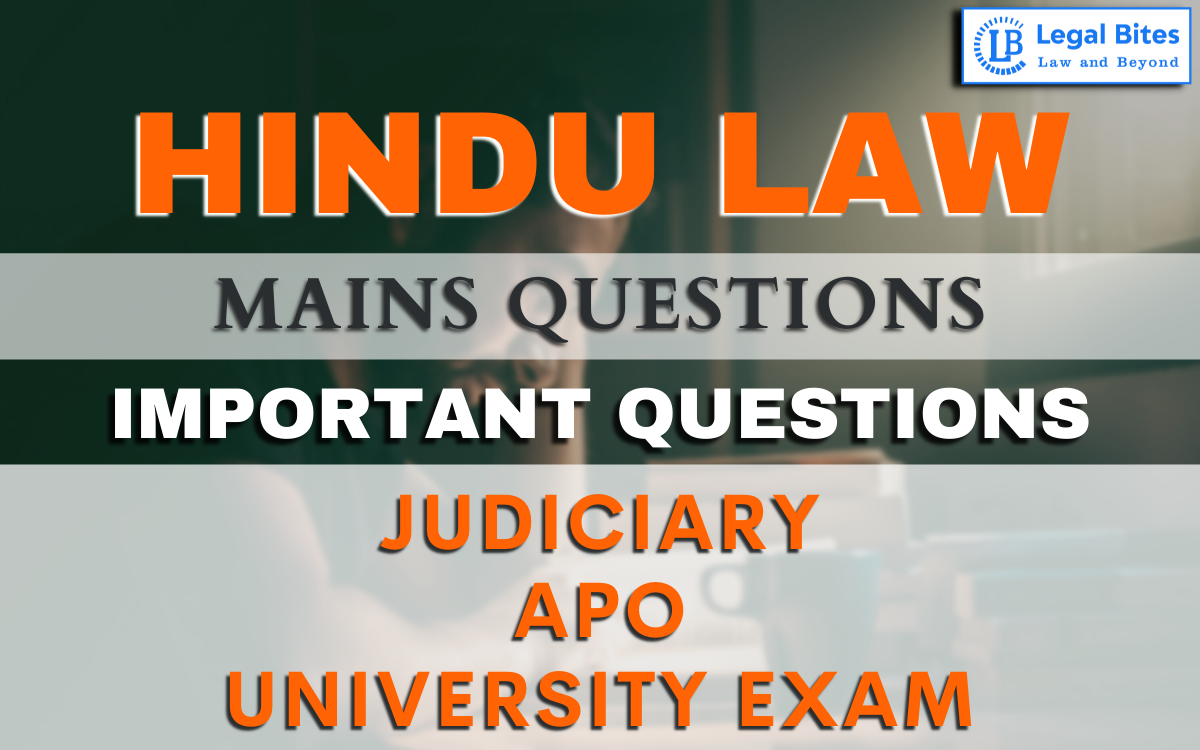What is Partition and how does it differ in Dhayabhaga and Mitakshara schools? Name some properties which are incapable of division.
Question: What is Partition and how does it differ in Dhayabhaga and Mitakshara schools? Name some properties which are incapable of division. Find the answer only on Legal Bites. [What is Partition and how does it differ in Dhayabhaga and Mitakshara schools? Name some properties which are incapable of division.] What is Partition? In a layman’s terminology, the… Read More »

Question: What is Partition and how does it differ in Dhayabhaga and Mitakshara schools? Name some properties which are incapable of division. Find the answer only on Legal Bites. [What is Partition and how does it differ in Dhayabhaga and Mitakshara schools? Name some properties which are incapable of division.] What is Partition? In a layman’s terminology, the partition can be referred to as the division of property into two or more parts. Under the Hindu Law, partition means the...
Question: What is Partition and how does it differ in Dhayabhaga and Mitakshara schools? Name some properties which are incapable of division.
Find the answer only on Legal Bites. [What is Partition and how does it differ in Dhayabhaga and Mitakshara schools? Name some properties which are incapable of division.]
What is Partition?
In a layman’s terminology, the partition can be referred to as the division of property into two or more parts. Under the Hindu Law, partition means the dividing of a Joint Hindu Family into separate parts for conferment of status on the undivided coparceners. It is pertinent to note that no partition is possible if there is only a single coparcener in a Joint family. A coparcener is a person who inherits estate as a coheir with others.
The concept of a coparcener is an integral part of the Joint family property in accordance with Hindu Law. Each of the coparceners has an equal share of the property of the Joint Hindu Family and each of them reserves an inherent title to the property. If a Hindu Joint family decides to do partition, then its joint status of a family comes to an end. However, in order to establish a state of jointness among the coparceners in a family, it is imperative to have at least two coparceners present in the family.
A partition can be possible of the property which is capable of being partitioned. Generally, it implies the partition of Coparcenery property. If at all there is a separate property of any of the coparceners in the Joint family it cannot be subjected to partition.
In the case of Mrutunjay Mohapatra v. Prana Krushna Mohapatra,
the Court stated that when the elder brother had purchased the property from his personal funds it cannot be subjected to partition and included in the Joint Family at the instance of a younger brother.
Mitakshara and Dayabhaga School
Before the codification of the modern Hindu law i.e., the Hindu Succession Act of 1956, there existed ancient schools of Hindu law by the name Dayabhaga and Mitakshara Schools. The Dayabhaga School was prevalent particularly in regions of Bengal and Assam whereas the Mitakshara School was followed majorly across all the other parts of the country.
Partition under both the school’s deals with the joint family property. Any property possessed by a coparcener does not count under the ambit of partition. However, certain properties such as common staircase, garden, utensils, etc. because of their indivisible nature. In such a case, the indivisible properties can be divided by three methods:
- Firstly, by using the property in turns or jointly.
- Secondly, allotting the share of a coparcener and adjusting its value with the other properties allotted
- Thirdly, by selling the property and distributing the sale proceeds among the coparceners.
In the Dayabhaga School, when the partition is claimed by any coparcener, the division of property takes place in such a manner that the share does not fluctuate through the birth or death of coparceners. However, this is not the case with Mitakshara School. In Mitakshara School, the division happens like the division of status, where the share fluctuates through the birth and death of a coparcener.
Who can Initiate Partition
In the Mitakshara School, the coparcenary comprises the father, son, grandson, and great-grandson (up to four degrees). This means that all of the abovementioned persons can demand a partition. However, in Dayabhaga School, the son, grandson and great-grandson cannot ask for partition till the time their common ancestor (father) is alive. Moreover, in Mitakshara School, when a suit for partition is initiated, then the partition takes place at that very moment.
To understand it better, there are two stages in a Mitakshara partition, the first being the severance of status and the second being the division of property. Hence, upon the initiation of the suit, the common meeting of mind confirms the severance of status, and only the division of the property is left. However, in the Dayabhaga School, only the filing of the suit does not initiate partition, but partition takes place upon the decree of the court.
Women’s Share
With respect to the share of the wife, in Mitakshara school, the wife or widow of the coparcener gets a share, even though she cannot initiate a partition. However, in the Dayabhaga School, the wife is not entitled to any share, and all the powers of shares are given to the husband. With regard to the stepmother, in Mitakshara School, she is entitled to a share in the partition, whether she has a son or is sonless. On the contrary, in Dayabhaga School, a sonless stepmother has no share in the property upon partition.
Admin Legal Bites
Legal Bites Study Materials correspond to what is taught in law schools and what is tested in competitive exams. It pledges to offer a competitive advantage, prepare for tests, and save a lot of money.
